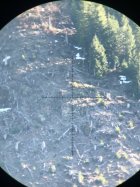That title may not end up being accurate, but it's the best I could come up with given what I'm interested in understanding better. I know there are some super smart people here who probably know this already or possibly some folks who have wondered what we were pondering. Similar conversation to the PRS guys wanting flatter caliber choices, but I've not heard any of them talk the math out other than 'flatter and more hits'.
A few of us were shooting the 2k steel the other day and afterwards we brought up the same old discussion about the 'effective' target size from a pill coming in at say a 150ft apex for example on to a 60"x60" target. When we are all over 20mils regardless of calibers available to the various guys on the 2k line we got to wondering what the actual difference was b/t a 6.5 or a 300NM/338/375 etc
To put it another way let's say you are a bug riding the nose of that bullet from apex as is begins it's trip down to the 60x60 steel.....seems to me he would not be seeing a full 60"x60" steel target but something that looks a lot smaller? Is there a mathematical formula for calculating this effective target size?
Apologize if I butchered that description and this isn't mission critical just a question that lingers repeatedly. Thanks
A few of us were shooting the 2k steel the other day and afterwards we brought up the same old discussion about the 'effective' target size from a pill coming in at say a 150ft apex for example on to a 60"x60" target. When we are all over 20mils regardless of calibers available to the various guys on the 2k line we got to wondering what the actual difference was b/t a 6.5 or a 300NM/338/375 etc
To put it another way let's say you are a bug riding the nose of that bullet from apex as is begins it's trip down to the 60x60 steel.....seems to me he would not be seeing a full 60"x60" steel target but something that looks a lot smaller? Is there a mathematical formula for calculating this effective target size?
Apologize if I butchered that description and this isn't mission critical just a question that lingers repeatedly. Thanks
Last edited:











